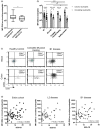Recruitment of activated neutrophils correlates with disease severity in adult Crohn's disease
- PMID: 30347439
- PMCID: PMC6330654
- DOI: 10.1111/cei.13226
Recruitment of activated neutrophils correlates with disease severity in adult Crohn's disease
Abstract
Neutrophils are detected in inflamed colon in Crohn's disease (CD). However, whether the frequency and/or activation of circulating or gut tissue neutrophils correlate with endoscopic severity remains to be investigated. A cohort of 73 CD patients was prospectively enrolled according to endoscopic severity and treatment history. Individuals with active disease were stratified using the Montreal classification. Harvey-Bradshaw Index (HBI) and Simple Endoscopic Score for Crohn's Disease (SES-CD) were performed at the time of ileocolonoscopy. Frequency of neutrophils and their expression of CD66b and CD64 were assessed in paired blood and colonic biopsies using flow cytometry. The percentage of neutrophils increased in inflamed colon and correlated with SES-CD in the entire cohort of patients examined, as well as in the subgroup with inflammatory (B1) active disease. SES-CD further correlated with neutrophil CD66b expression in mucosa but not blood and, conversely, with neutrophil CD64 expression in blood but not mucosa. However, the evaluation of neutrophil activation in mucosa when compared to blood reflected disease activity more clearly. Finally, a neutrophil activation power index (CD66b in mucosa X CD64 in blood) that correlated with SES-CD discriminated between patients with mild and severe disease. In conclusion, the frequency and activation of colonic neutrophils correlated with SES-CD, highlighting that mucosal neutrophils are associated with disease severity in CD.
Keywords: CD64; CD66b; Crohn’s disease; SES-CD; neutrophil.
© 2018 British Society for Immunology.
Figures




References
-
- Ng SC, Shi HY, Hamidi N et al Worldwide incidence and prevalence of inflammatory bowel disease in the 21st century: a systematic review of population‐based studies. Lancet 2018;390:2769–78. - PubMed
-
- Magro F, Langner C, Driessen A et al European consensus on the histopathology of inflammatory bowel disease. J Crohns Colitis 2013;7:827–51. - PubMed
-
- Lemmens B, Arijs I, Van Assche G et al Correlation between the endoscopic and histologic score in assessing the activity of ulcerative colitis. Inflamm Bowel Dis 2013;19:1194–201. - PubMed
-
- Yoon J, Terada A, Kita H. CD66b regulates adhesion and activation of human eosinophils. J Immunol 2007;179:8454–62. - PubMed
Publication types
MeSH terms
Substances
Grants and funding
LinkOut - more resources
Full Text Sources
Medical
Research Materials
Miscellaneous

